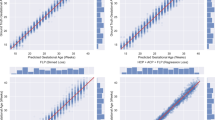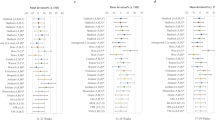Abstract
A multinormal probability model is proposed to correct human errors in fetal echobiometry and improve the estimation of fetal weight (EFW). Model parameters were designed to depend on major pregnancy data and were estimated through feed-forward artificial neural networks (ANNs). Data from 4075 women in labour were used for training and testing ANNs. The model was implemented numerically to provide EFW together with probabilities of congruence among measured echobiometric parameters. It enabled ultrasound measurement errors to be real-time checked and corrected interactively. The software was useful for training medical staff and standardizing measurement procedures. It provided multiple statistical data on fetal morphometry and aid for clinical decisions. A clinical protocol for testing the system ability to detect measurement errors was conducted with 61 women in the last week of pregnancy. It led to decisive improvements in EFW accuracy.



Similar content being viewed by others
References
Armitage P, Berry G (1987) Statistical methods in medical research. Blackwell, Oxford
Ben-Haroush A, Yogev Y, Hod M (2004) Fetal weight estimation in diabetic pregnancies and suspected fetal macrosomia. J Perinat Med 32(2):113–121
Benson CB, Doubilet PM, Saltzman DH (1987) Sonographic determination of fetal weights in diabetic pregnancies. Am J Obstet Gynecol 156(2):441–444
Bettelheim D, Deutinger J, Bernaschek (1997) Fetal sonographic biometry: a guide to normal and abnormal measurements. The Parthenon Publishing Group
Biagioli B, Scolletta S, Cevenini G, Barbini E, Giomarelli P, Barbini P (2006) A multivariate Bayesian model for assessing morbidity after coronary artery surgery. Crit Care 10(3):R94. doi:10.1186/cc4951
Bishop HCM (1995) Neural networks for pattern recognition. Clarendon, Oxford
Chauhan SP, Hendrix NW, Magann EF, Morrison JC, Kenney SP, Devoe LD (1998) Limitations of clinical and sonographic estimates of birth weight: experience with 1034 parturients. Obstet Gynecol 91(1):72–77
Chauhan SP, West DJ, Scardo JA, Boyd JM, Joiner J, Hendrix NW (2000) Antepartum detection of macrosomic fetus: clinical versus sonographic, including soft-tissue measurements. Obstet Gynecol 95(5):639–642
Chauhan SP, Hendrix NW, Magann EF, Morrison JC, Scardo JA, Berghella V (2005) A review of sonographic estimate of fetal weight: vagaries of accuracy. J Matern Fetal Neonatal Med 18(4):211–220
Chauhan SP, Cole J, Sanderson M, Magann EF, Scardo JA (2006) Suspicion of intrauterine growth restriction: use of abdominal circumference alone or estimated fetal weight below 10%. J Matern Fetal Neonatal Med 19(9):557–562
Chuang L, Hwang JY, Chang CH, Yu CH, Chang FM (2002) Ultrasound estimation of fetal weight with the use of computerized artificial neural network model. Ultrasound Med Biol 28(8):991–996
Cohen J, Cohen P, West SG, Aiken LS (2003) Applied multiple regression: correlation analysis for the behavioral sciences. Erlbaum, London
Colman A, Maharaj D, Hutton J, Tuohy J (2006) Reliability of ultrasound estimation of fetal weight in term singleton pregnancies. New Zeal Med J 119(1241):U2146
Combs CA, Jaekle RK, Rosenn B, Pope M, Miodovnik M, Siddiqi TA (1993) Sonographic estimation of fetal weight based on a model of fetal volume. Obstet Gynecol 82(3):365–370
Coomarasamy A, Connock M, Thornton J, Khan KS (2005) Accuracy of ultrasound biometry in the prediction of macrosomia: a systematic quantitative review. Brit J Obstet Gynaec 112(11):1461–1466
Dudley NJ (1995) Selection of appropriate ultrasound methods for the estimation of fetal weight. Brit J Radiol 68:385–388
Dudley NJ (2005) A systematic review of the ultrasound estimation of fetal weight. Ultrasound Obstet Gynecol 25(1):80–89
Edwards A, Goff J, Baker L (2001) Accuracy and modifying factors of the sonographic estimation of fetal weight in a high-risk population. Aust NZ J Obstet Gyn 41(2):187–190
Etter DM, Kuncicky DC, Moore H (2005) Introduction to MATLAB 7. Prentice Hall, Englewood Cliffs
Farmer RM, Medearis AL, Hirata GI, Platt LD (1992) The use of a neural network for the ultrasonographic estimation of fetal weight in the macrosomic fetus. Am J Obstet Gynecol 166(5):1467–1472
Goldberg JD (2004) Routine screening for fetal anomalies: expectations. Obstet Gynecol Clin North Am 31(1):35–50
Hadlock FP, Harrist RB, Sharman RS, Deter RL, Park SK (1985) Estimation of fetal weight with the use of head, body, and femur measurements - a prospective study. Am J Obstet Gynecol 151:333–7
Hadlock FP (1990) Sonographic estimation of fetal age and weight. Fetal Ultrasound 28(1):39–51
Haykin S (1994) Neural networks: a comprehensive foundation. Maxwell Macmillian, Canada
Hill LM, Breckle R, Gehrking WC, O’Brien PC (1985) Use of femur length in estimation of fetal weight. Am J Obstet Gynecol 152:847–852
Jamshidi M (2003) Tools for intelligent control: fuzzy controllers, neural networks and genetic algorithms. Philos Transact A Math Phys Eng Sci 361(1809):1781–1808
Jordaan HV (1983) Estimation of fetal weight by ultrasound. J Clin Ultrasound 11(2):59–66
Krzanowski WJ (1988) Principles of multivariate analysis: a user’s perspective. Clarendon, Oxford
Kurmanavicius J, Burkhardt T, Wisser J, Huch R (2004) Ultrasonographic fetal weight estimation: accuracy of formulas and accuracy of examiners by birth weight from 500 to 5000 g. J Perinat Med 32(2):155–161
Lee YB, Kim MJ, Kim MH (2007) Robust border enhancement and detection for measurement of fetal nuchal translucency in ultrasound images. Med Biol Eng Comput (Spec issue). doi:10.1007/s11517-007-0225-7
Lockwood CJ, Weiner S (1986) Assessment of fetal growth. Clin Perinatol 13(1):3–35
Mongelli M, Biswas A (2002) Menstrual age-dependent systematic error in sonographic fetal weight estimation: a mathematical model. J Clin Ultrasound 30(3):139–44
Ott WJ, Doyle S, Flamm S, Wittman J (1986) Accurate ultrasonic estimation of fetal weight. Prospective analysis of a new ultrasonic formula. Am J Perinatol 3(4):307–10
Ott WJ (2006) Sonographic diagnosis of fetal growth restriction. Clin Obstet Gynecol 49(2):295–307
Robson SC, Gallivan S, Walkinshaw SA, Vaughan J, Rodeck CH (1993) Ultrasonic estimation of fetal weight: use of targeted formulas in small for gestational age fetuses. Obstet Gynecol 82(3):359–364
Rosati P, Exacoustos C, Caruso A, and Mancuso S (1992) Ultrasound diagnosis of fetal macrosomia. Ultrasound Obstet Gynecol 2(1):23–29
Rotmensch S, Celentano C, Liberati M, Malinger G, Sadan O, Bellati U, Glezerman M (1999) Screening efficacy of the subcutaneous tissue width/femur length ratio for fetal macrosomia in the non-diabetic pregnancy. Ultrasound Obstet Gynecol 13(5):340–344
Sabbagha RE, Minogue J, Tamura RK, Hungerford SA (1989) Estimation of birth weight by use of ultrasonographic formulas targeted to LGA, AGA, and SGA fetuses. Am J Obstet Gynecol 160:854–862
Sargent DJ (2001) Comparison of artificial neural networks with other statistical approaches: results from medical data sets. Cancer 91(S8):1636–1642
Schild RL, Fimmers R, Hansmann M (2000) Fetal weight estimation by three-dimensional ultrasound. Ultrasound Obstet Gynecol 16(5):445–452
Secher NJ, Djursing H, Hansen PK, Lenstrup C, Sindberg-Eriksen P, Thomsen BL, Keiding N (1987) Estimation of fetal weight in the third trimester by ultrasound. Eur J Obstet Gynecol Reprod Biol 24:1–11
Sladkevicius P, Saltvedt S, Almstrom H, Kublickas M, Grunewald C, Valentin L (2005) Ultrasound dating at 12–14 weeks of gestation. A prospective cross-validation of established dating formulae in in vitro fertilized pregnancies. Ultrasound Obstet Gynecol 26(5):504–511
Thornton JG, Hornbuckle J, Vail A, Spiegelhalter DJ, Levene M, GRIT study group (2004) Infant wellbeing at 2 years of age in the growth restriction intervention trial (GRIT): multicentred randomised controlled trial. Lancet 364(9433):513–520
Woo JS, Wan MC (1986) An evaluation of fetal weight prediction using a simple equation containing the fetal femur length. J Ultrasound Med 5(8):453–457
Acknowledgments
This work was financed by the Italian Ministry of Education, University and Research (MIUR). Special thanks to ESAOTE S.p.A., Genoa, Italy, for its precious and prompt technical support.
Author information
Authors and Affiliations
Corresponding author
Rights and permissions
About this article
Cite this article
Cevenini, G., Severi, F.M., Bocchi, C. et al. An informative probability model enhancing real time echobiometry to improve fetal weight estimation accuracy. Med Bio Eng Comput 46, 109–120 (2008). https://doi.org/10.1007/s11517-007-0299-2
Received:
Accepted:
Published:
Issue Date:
DOI: https://doi.org/10.1007/s11517-007-0299-2




